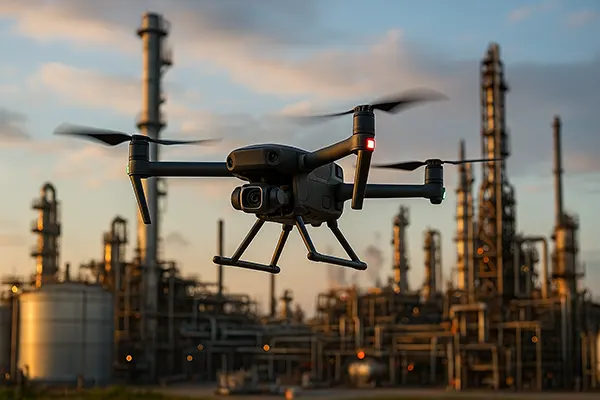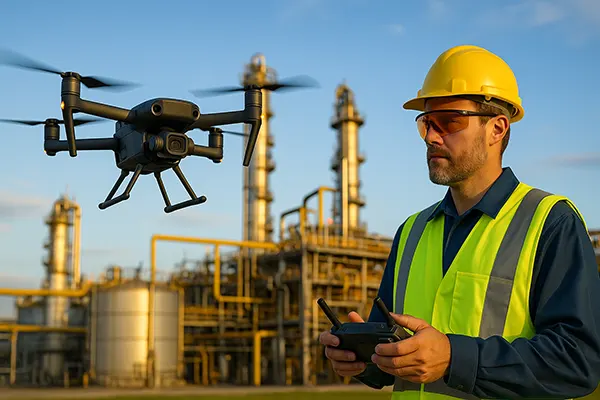
AI Drones for Industry and Security: New Opportunities in 2025
Artificial intelligence has transformed the way unmanned aerial vehicles are applied in industrial operations and public safety. In 2025, AI-driven drones are no longer experimental tools but practical assets deployed by corporations, governments, and security agencies. Their integration enables precise monitoring, predictive analysis, and enhanced efficiency, making them a central element of modern infrastructure and protection strategies.
Industrial Applications of AI Drones
In manufacturing and logistics, drones powered by AI are now capable of carrying out inspections of pipelines, machinery, and warehouses with remarkable accuracy. They identify early signs of wear, predict potential failures, and reduce downtime, offering businesses cost savings and reliability. Beyond inspections, these systems are used for mapping construction sites and coordinating complex industrial processes in real time.
The energy sector benefits significantly from drone deployment. In wind farms and solar parks, AI drones perform autonomous checks on turbines and panels, identifying defects invisible to the human eye. This automation ensures renewable energy facilities maintain optimal performance and contributes to global sustainability goals. As demand for clean energy rises, drones serve as a critical bridge between technological innovation and environmental responsibility.
Another area where drones demonstrate value is agriculture. Equipped with AI-driven sensors, they monitor soil conditions, crop health, and irrigation systems, providing actionable insights to farmers. Precision agriculture in 2025 relies heavily on these drones to improve yields, conserve resources, and adapt to changing climate conditions.
Enhancing Efficiency and Reducing Risks
The key advantage of AI in industrial drone use lies in predictive capabilities. By processing large volumes of data collected during flights, drones anticipate risks before they escalate into costly incidents. This proactive approach reduces human involvement in hazardous environments such as chemical plants, mines, and offshore rigs.
Operational efficiency is also strengthened by the ability of drones to communicate with central management systems. AI enables drones to transmit real-time insights, supporting decision-making processes without delays. This integration ensures industries maintain high safety standards while optimising workflow.
Moreover, drones reduce insurance and liability costs for companies by minimising workplace accidents. With fewer staff exposed to danger and more reliable monitoring tools in place, organisations achieve both financial and ethical benefits.
AI Drones in Public Safety and Security
In urban environments, drones serve as essential tools for law enforcement and emergency responders. They are used to monitor large gatherings, track suspicious activity, and provide live data during critical incidents. Their mobility and unobstructed aerial view give security teams an edge in managing complex situations with speed and accuracy.
Border security has also been reshaped by drone technology. AI-driven surveillance systems scan vast territories, detect unauthorised movements, and differentiate between natural phenomena and potential threats. This prevents unnecessary false alarms while improving overall response times for border patrol forces.
Emergency management agencies integrate drones into disaster response strategies. During floods, fires, and earthquakes, drones deliver supplies, locate survivors, and provide visual intelligence to rescue teams. Their capacity to function in areas inaccessible to humans makes them indispensable assets in safeguarding communities.
Ethical and Legal Considerations
While the benefits are evident, the rise of AI drones raises questions of privacy and regulation. Governments in 2025 are implementing frameworks to ensure drone use respects individual rights and complies with international security laws. Clear policies are necessary to balance innovation with accountability.
Public trust is critical to the success of these technologies. Transparency about how data is collected, stored, and used plays a key role in acceptance. Without proper safeguards, drones could face resistance from communities concerned about surveillance.
At the same time, ethical guidelines encourage the responsible deployment of drones, ensuring their use enhances safety without infringing on freedoms. This approach reflects a growing recognition that technological progress must align with societal values.

Future Prospects of AI Drone Technology
Looking ahead, the role of drones in industry and security will continue to expand. Advances in machine learning are expected to increase autonomy, allowing drones to perform complex missions without constant human oversight. Integration with other technologies, such as 5G networks and quantum computing, will enhance processing speeds and decision-making.
The global market for AI drones is projected to grow rapidly over the next decade. Governments and enterprises see them as a cost-effective way to strengthen resilience and competitiveness. Research and development investments are accelerating, focusing on improving battery life, flight range, and sensor capabilities.
Beyond their current uses, drones may soon become vital contributors to smart cities. They will work alongside autonomous vehicles, IoT networks, and advanced robotics, forming part of interconnected systems that shape urban life. This synergy could revolutionise both economic activity and daily living.
Challenges and Innovation Opportunities
Despite rapid progress, challenges remain. Airspace management, cyber-security, and environmental concerns require ongoing solutions. Unregulated drone proliferation could lead to risks of collisions, misuse, or disruption of critical infrastructure. Addressing these issues will demand international cooperation and consistent enforcement.
Innovation, however, thrives in addressing such challenges. Companies developing AI drones are working on adaptive flight algorithms, stronger security systems, and eco-friendly designs. Collaboration with regulators and communities ensures these innovations align with public needs and expectations.
Ultimately, AI drones represent not just tools of convenience but a transformative force reshaping how industries and societies function. Their development reflects the dynamic balance between technology, responsibility, and opportunity in 2025.
